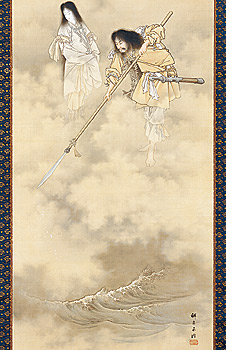|
|
The
Kami
The
gods of Shinto are called Kami.
The term Kami refers to nature spirits or Spirit of Nature.
It is both one and many, manifest both in and as nature.
"Kami"
is a collective (singular) term which refers to nature as a whole or it can also
refer to any of the countless manifestations of nature recognized as individual
gods and goddesses:
-
One
can refer to "a kami", "this kami", "that kami"
or the term can be used to refer to the collective as a single, whole unit
(e.g., "The Borg" or "the hive"). The term "Kami"
is like the term "fish" - it can be both singular and plural.
-
Nature
embodies or makes manifest a sublime spirit, one in essence but many in
manifest form -
Thus,
typical of most indigenous, nature based religions, Shinto is a polytheistic
system. But the
terms pantheism and animism also apply:
-
As
a pantheistic system, Shinto sees the divine in all things in nature.
-
As
an animistic system, Shinto believes all forms of nature are animated by
spirit - the spirit of nature itself is a living spirit that is infused in
all elements of nature.
Mythically,
the spirits are personified as gods and goddesses all originating with a single,
spontaneously evolved divinity - a "family" of spirits
("family" is also a collective singular concept)
|
 |
These
deities are named, some male, some female, often working in pairs e.g., Izanagi
("male") and Izanami ("female") as the original
brother & sister pair who created the world with Japan at the center (c.f. Hindu Purusha
and Prakriti).
Of course, every culture imagines that it is the center of the world, the
place where it all began: Mecca is the center of the Muslim world, Jerusalem in
the center of the Jewish world, Rome in the center of the Catholic world... |
|
Some
deities are associated with various physical, natural elements of Japanese
landscape: mountains (especially Mt. Fuji), valleys, rivers, waterfalls, the
ocean, the rising sun (Amaterasu). Other deities are identified with natural
forces e.g., wind, rain, the passing of the seasons or the movement of the stars
|

|
return to top
|

